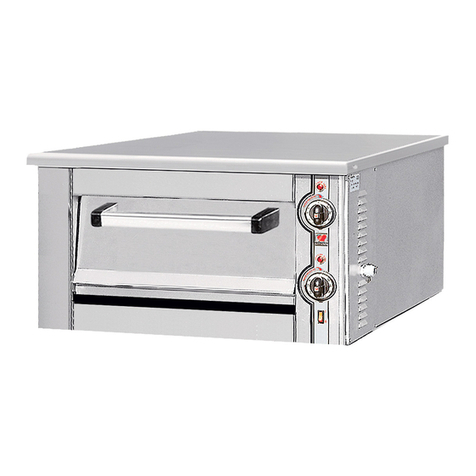
1.1 Standards and Require ents
We would like to remind you that appliances installed in places open to the public should meet specific
requirements. Among them there are:
• Specific standards for the type of public place.
• Safety standards against fire and cause of panic in public place.
• General standards for the installation of cooking appliances in refreshment facilities.
• General standards concerning installation using combustible gas and liquid hydrocarbons.
• GENERAL WARNINGS
o Before you install and place in operation the appliance you carefully read the present
handbook that offers important information
o Keep the handbook carefully for future use for the operators or for case of after sale
o This appliance is intended for special industrial use and has been studied for the baking of
foods. Any other use is deemed improper.
o This appliance should be used by educated personnel and it is supervised at the duration of
operation
o Disconnect the appliance in case of damage or bad operation
o For repair you are addressed only in permitted centre of technical support of constructor and
require the placement of original parts
o The above instruction is for the safety and the correct function of the appliance not to cause
damages.
o Don't use for the cleaning of steel products that contain chloride even if they are dissolved
o Do not use corrosive substances in order to you clean the flooring under the appliance
1.2 Packing
Make sure packing is intact before removing the appliance. Open cardboard carefully to ensure no metal
stapling, adhesive tape or other packing components litter the environment, as these can prove hazardous.
1.2 Obstacles and Position
Where this appliance is to be positioned in close proximity to a wall, partitions, kitchen furniture, decorative
finishes etc; it is recommended that they be made of non combustible material. If not, they should be clad
with a suitable non combustible heat insulating material, and that the closest attention be paid to Fire
Prevention Regulations
• Make sure there is enough space available for the placement of the appliance. Make sure that the
surface it stands on is stable and level.
• Remove the protective tape from the external parts of the appliance, making sure no glue or plastic
is stuck on the surface. If there are residues of glue, remove them using the right solvent.
• Make sure the appliance is level on the surface available. If necessary, regulate its height
accordingly, by adjusting the legs of the appliance.





























